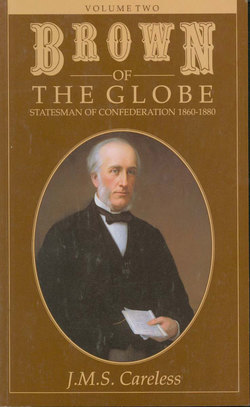Читать книгу Brown of the Globe - J.M.S. Careless - Страница 8
На сайте Литреса книга снята с продажи.
ОглавлениеPreface
This is the second and concluding volume on the life of George Brown, 1818-1880, Canadian journalist and Liberal party leader. The first volume, which ran to the end of 1859, dealt with Brown’s Scottish boyhood, his first years in North America spent in New York, and his removal to Canada in 1843. It described his founding of the Toronto Globe in 1844, and his entrance into active politics on the Reform side; his first election to parliament in 1851, and his rise to the leadership of the powerful Reform or Liberal party of Upper Canada, generally known as the Clear Grits, during the sectional conflict of the 1850s. From that point on, the present study traces Brown’s growing association with the movement for the confederation of the British North American colonies, which became the allembracing issue of the decade of the sixties. It particularly emphasizes his contribution to the Confederation movement, for, as Lord Monck, Canada’s Governor-General of the time, declared himself, George Brown was “the man” whose conduct made the union of British North America feasible.
A man’s life is not lived at the same pace and pitch throughout. For the historian, not all parts of his life-span are of equal significance. Thus this volume particularly concentrates on the period between 1860 and the establishment of Confederation in 1867 as years in which Brown reached the peak of his achievement. Yet the years that followed, until his death in 1880, were by no means a mere epilogue to the parliamentary career he relinquished in 1867. His continued influence in the Liberal party and his power on the Globe gave him an important role in the newly-created Canadian federal union. Brown’s post-Confederation activities have much interest in themselves, as this present volume tries to show.
But above all, it tries to give George Brown his due weight in the story of Confederation, an endeavour greatly aided by the discovery of his private papers, now in the Public Archives of Canada. Brown has sorely needed re-examination. It is all too clear how stiff and meagre is the part he plays in popular Canadian tradition regarding Confederation. One simple indication is that he is generally envisaged among the “Fathers” of Confederation as a stern, white-headed Old Testament patriarch – instead of the vigorous, exuberant man of forty-five that he was at the time. His greatest adversary and essential partner in Confederation, John A. Macdonald, has now received a full and deserved restoration in Professor D. G. Creighton’s monumental biography. But George Brown no less deserves rescuing from the indifference and near-ignorance that Canadians so often display about their past. This book may not achieve the rescue. But at least it will have tried.
The list of those to whom I am indebted for aid in the preparation of this work is largely the same as for its predecessor; yet this in no way decreases my gratitude, or my pleasure in acknowledging the debt. Foremost on the list again are Mrs. G. M. Brown and Mr. G. E. Brown of Ichrachan House, Taynuilt, Argyll, Scotland, who permitted me to stay with them while examining a trunkful of George Brown’s private papers, and then allowed the whole valuable collection to be deposited in the Public Archives of Canada. But for their hospitality, generosity, and understanding, this biography would hardly have been possible. Next, assuredly, to be acknowledged is the always ready help provided by Dr. Kaye Lamb and his staff at the Public Archives of Canada, and the equally ready assistance of Dr. G. W. Spragge and his staff at the Provincial Archives of Ontario. I have every reason to know how much, indeed, the Canadian historian owes to the archival institutions of this country.
I have received valuable aid also at the Toronto Central Public Library, and at the Legislative Library of Ontario, where even after years of continued reappearance I seem never to have worn out my welcome. Among individuals (outside of institutions, I almost feel constrained to add) I must particularly acknowledge the generous interest of Professor Peter Waite of Dalhousie University, who has repeatedly sent me valuable items of information stemming from his own important researches in the Confederation period. Other individuals – especially Mr. Hugh McKanday of the Toronto Globe and Mail, members of the Brown family, and my own colleagues in the Department of History at the University of Toronto – will, I trust, accept a collective acknowledgement, and not consider my thanks in any sense diminished by it.
Finally, I am very glad to express my thanks once more for the financial grant received from the Rockefeller Corporation through the University of Toronto Committee administering Rockefeller funds, which helped support my basic research for this study in Scotland and England during 1955-6. And I am no less happy to recognize the aid received directly from the University of Toronto, which gave me leave of absence during the period mentioned and further assisted me by supporting additional researches in Ottawa and elsewhere in Canada, as well as providing funds towards meeting the costs of the preparation of my completed manuscript.
February 17, 1963
J. M. S. Careless
